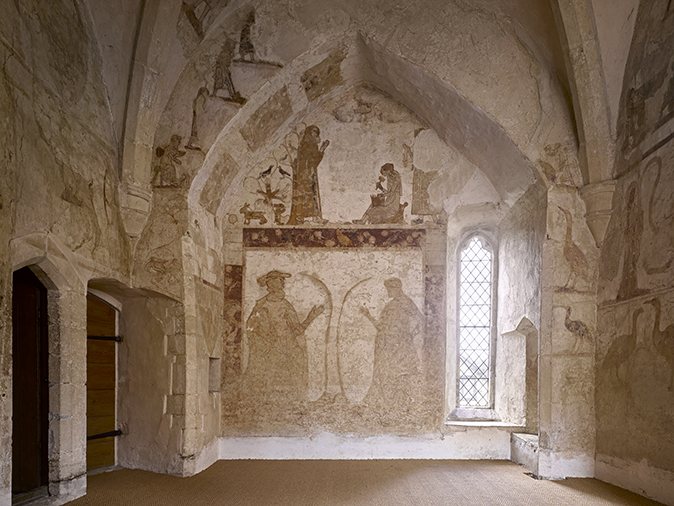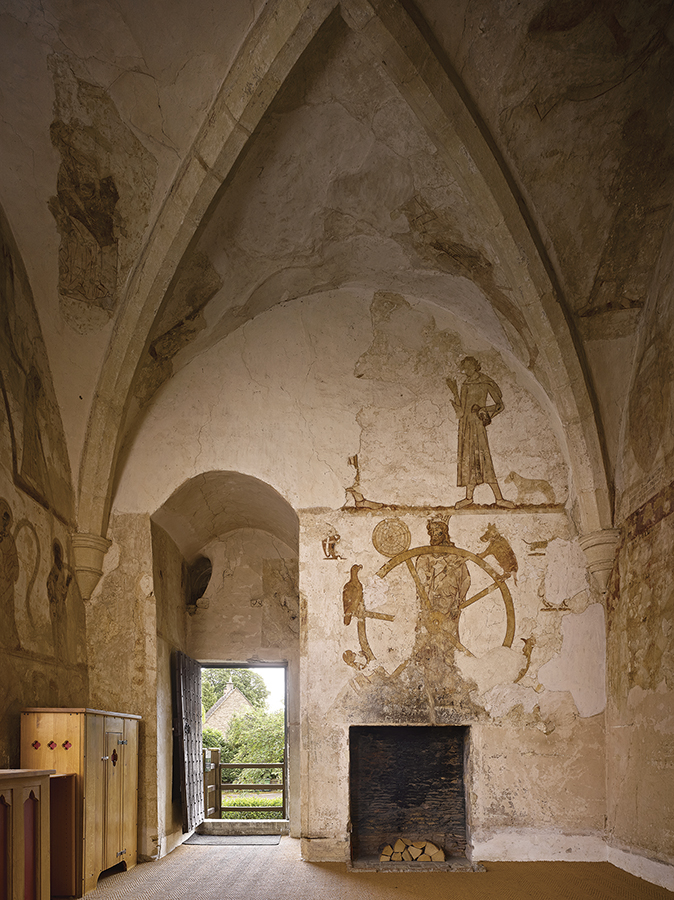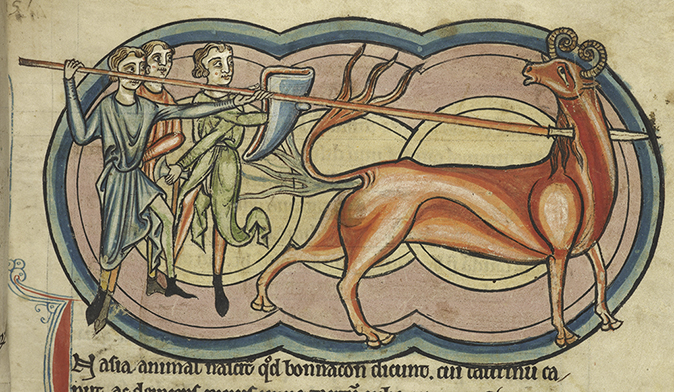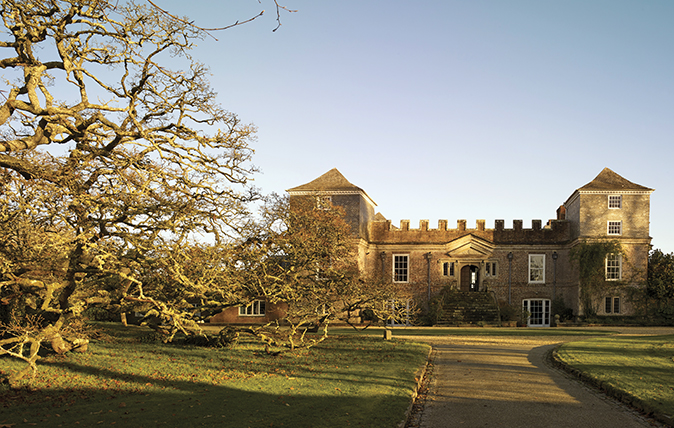Longthorpe Tower's 700-year-old insight into the medieval mind
This surviving cycle of 14th-century paintings still has the power to intrigue, amuse and inform. It also offers a remarkable insight into the medieval world view, as Edward Impey expains.


In September 1945, Hubert Horrell, dairy farmer at Tower Farm, at Longthorpe in Cambridgeshire, made an astonishing discovery. Removing layers of ancient whitewash in the first-floor room of the tower that gave the farm its name, Horrell was greeted by the hands, stares and bright colours of figures painted six centuries before.
Recognising something special, he contacted Hubert Elliot, agent of Milton Hall Estates and the Fitzwilliams (of Wentworth Woodhouse fame), owners of the property since the late 15th century. Elliot and Capt W. T. G Fitzwilliam – later the 10th and last Earl Fitzwilliam – wisely turned to the Society of Antiquaries of London, which called in its Fellow and wall-painting specialist, Edward Clive Rouse (1901–97).

Rouse then spent much of 1946–8 painstakingly removing the rest of the whitewash and making an exquisite scaled record in watercolour. What he revealed was truly remarkable (Country Life, April 4, 1947): not only the best-preserved medieval domestic wall-painting scheme in England, but one of the highest quality, representing a startling and puzzling variety of themes and images.
The house itself , largely surviving, if much altered, was built by the Thorpe family, a gifted dynasty of lawyers acting in the 13th century for Peterborough Abbey and later also for the King.
The 40ft-high tower, added by Robert Thorpe in about 1300, is much rarer, but has well-known parallels at Little Wenham Hall in Suffolk (about 1265–80) and at Stokesay Castle in Shropshire (about 1290), although its austerity is deliberately reminiscent of the gigantic four-square great towers of the 11th and 12th centuries (such as at Hedingham Castle in Essex).

In an area then frequented by marauding bandits, Thorpe built it partly for the security of his family, valuables and documents, although, as it happened, with limited success: in 1327, a gang of four men ‘together with other wrongdoers and disturbers of the peace by force of arms broke into his houses and chests’, stole £200 worth of goods and ‘imprisoned, detained and mistreated,’ him until promised £100 in ransom.
More successfully achieved was the tower’s main purpose as a status symbol, endowing Thorpe’s parvenu family with associations of authority, martial prowess, chivalry and ancient lineage. Fittingly, it was from its battlements, commanding the flat fenland for miles around, that the Home Guard watched vainly for paratroops in 1940.
Exquisite houses, the beauty of Nature, and how to get the most from your life, straight to your inbox.
Robert commissioned the paintings in about 1330 and, cosmopolitan, Latin-literate and educated, he probably picked the subjects himself. The painters he chose were also the very best—they were clearly familiar with a wide range of contemporary work, although variations in quality show that some were better than others.

The colours, variously mixed with egg white or oil, were originally very bright indeed and, in key places, picked out in gold leaf. The overall effect, not least in candlelight, must have been overwhelmingly rich and impressive.
The painted room is roughly 20ft square and is spanned by a stone vault. Every available surface bore decoration of some sort, but the main treatments are to the four main wall surfaces and the four quadrants of the vault.
Confronting the visitor today – entering through a doorway contrived from a window in the 1940s – is the west wall, on which the composition fills and surrounds a broad, deep window recess. At the top, over the recess, appear the Labours of the Month, a popular medieval theme. Much is missing, but January, at lower left and well preserved, is marked by a man warming himself at a fire, holding a hot drink. Above and to the left, April is represented by a man digging with a metal-edged wooden spade and December, at the far right, by a pig-killing.
Below, in the recess, are two more unusual scenes. At the top, as identified by the part-surviving inscription, is a scene from the life of St Anthony (standing), in which he asks God (originally appearing at the point of the arch) how to find salvation, the answer arriving in the form of an angel alternatively praying and working – the latter being represented here by basket-making.

Under this, surrounded by a border imitating embroidered cloth, two men engage in discussion: the curved lines seen between them are the remains of scrolls, now tantalisingly illegible, but which originally explained their dialogue.
The north wall displays another popular sequence, the Seven Ages of Man, following, both pictorially and symbolically, the upward and downward curve of the vault.
Framed by this series, above the window embrasure, a Nativity strikes a brighter note, the Virgin reclining on a bed and holding the swaddled Christ Child, with Joseph seated to the right on a chair. An ear and a horn belonging to the ox, along with the ass’s ears can just be made out to the left and right of the central damaged area. Below, at right and left, are four figures from a line-up of the Apostles.
Turning to the east wall, the main survival of the upper scene, beautifully drawn, is a figure of a young man holding his gloves and clearly in discussion with another man, of whom only the foot, scabbard tip and raised finger survive: between them is another illegible inscription.

Below, more complete but equally enigmatic, is the most remarkable of the Longthorpe scenes: a crowned man stands behind a wheel. At first reminiscent of the more common representations of the Wheel of Fortune or the Wheel of Life, this appears to be a conflation of the same graphic concept with a literary pairing of animals and the senses (the spider with touch, the boar with hearing, and so on), of Classical inspiration, but formalised in the mid–13th-century Liber de Naturis Rerum (Book of the Nature of Things) by the Flemish Dominican friar Thomas de Cantimpré. As a result, historians have called it the Wheel of the Five Senses.
Theories abound as to its meaning, but the simplest is that it notes the height of these creatures’ senses compared to Man’s, but also Man’s possession of reason (pointing to and turning the wheel) and thus his capacity and obligation to restrain himself in the face of sensory experience.
Whatever the truth, its rarity underlines the special nature of the Longthorpe scheme: the only known parallels are found in the Cistercian monastery of Tre Fontane in Rome of the 13th century and another, roughly contemporary with Longthorpe, in a house in Constance in south-west Germany.
Adjacent to this, in the door embrasure, but startlingly different, is a more morbid scene: the Three Living and the Three Dead Kings.
On the south wall, below the vault, two enthroned figures face each other, flanked by shields, the left hand one originally bearing the lions passant gardant of Edward III’s arms before the addition of fleurs de lis in 1340 (and so probably Edward II or III, and the arms of Edmund of Woodstock, half-brother of Edward II). Why they are here is puzzling, but the scene probably paid homage to the King as Thorpe’s employer (or former employer) and to the Earl perhaps as one of his landlords, but, possibly most importantly, it draws attention to the patron’s links with the ruling elite.
Below is a painting of a valuable textile surrounded by a border. To the right, either by way of scurrilous satire or just for a laugh, an archer rashly shoots at a Bonnacon, a mythical creature that dispatched its adversaries in a shower of flaming excrement.
Last but not least, Thorpe and his painters turned to the vaulted ceiling. Originally, each quadrant bore one of the symbols of the four Evangelists, of which the Ox of St Luke and the Eagle of St John can still be made out, accompanied by musicians playing the instruments named in the 150th Psalm (‘Praise him with the sound of the trumpet…’).
Each of these scenes, in all their bewildering variety, has its own appeal, but what do they add up to? What was Thorpe trying to achieve with his extraordinary room? At its simplest, he must have aimed to create both a sumptuous and impressive interior and a source of immediate delight and entertainment, the more sombre scenes deftly balanced by birds, animals and touches of humour.
Viewed more forensically, it offered a range of challenge and instruction, through visual, verbal and philosophical riddles, feeding on an interest in numbers (especially 12, seven, five and three) and their symbolism, inherited from the ancient world. At the same time, it would have reminded the viewer of the Thorpes’ status and connections, particularly through heraldry and representations of royalty, and impressed the educated onlooker, both through the images and the abundant Latin and French texts, with their learning.
Above all perhaps is the theme of redemption and the hope of the afterlife, never far from the medieval mind, expressed by mementos of mortality (the Three Kings and the Ages of Man) on the one hand and the birth of Christ, the Apostles and reminders of the path to Salvation (St Anthony) on the other, all under an enticing painted canopy of Heaven.
How Thorpe used the room is pure guesswork, but its small size and restricted access suggest a private space for working and receiving special guests and clients. The fictive textile panel was perhaps a backdrop to his chair, from which, warmed by the adjacent fire, he received them and viewed the decor to the best advantage.
How long the paintings remained appreciated is equally unclear, as, from the 1350s, the Thorpe family lived elsewhere and the last member died childless in 1391. From then until the 1970s, the place was occupied by tenants and it was in this era, whether for ideological or other reasons, that the paintings were covered over. Prompt action by the tenant and the estate in 1948, however, ensured their re-emergence and survival.
In that year, Capt Fitzwilliam gave the tower to the nation and, after a long programme of consolidation, it was opened to the public by the Ministry of Works and remained so under English Heritage. Today, it is run on its behalf by Vivacity Heritage Ltd and open by appointment.
For further information, visit www.english-heritage.org.uk/visit/places/longthorpe-tower

A miniature castle in Kent that sits alongside a magnificent folly tower
In the shadow of one of Victorian England's most famous follies lies a beautiful family home in Kent that is

Ince Castle, Cornwall: A country house risen from the flames
A serious fire can be the end of a country house, but, on occasion, it can also offer the opportunity

Cumberland Lodge: The 17th century marvel 'a thousand times more agreeable than Blenheim'
This year, a remarkable educational foundation in a spectacular parkland setting celebrates its 70th anniversary. John Goodall considers the history
Country Life is unlike any other magazine: the only glossy weekly on the newsstand and the only magazine that has been guest-edited by His Majesty The King not once, but twice. It is a celebration of modern rural life and all its diverse joys and pleasures — that was first published in Queen Victoria's Diamond Jubilee year. Our eclectic mixture of witty and informative content — from the most up-to-date property news and commentary and a coveted glimpse inside some of the UK's best houses and gardens, to gardening, the arts and interior design, written by experts in their field — still cannot be found in print or online, anywhere else.
